
In a quiet Tokyo residential neighborhood is where you'll find the home of Norimatsu Sachiko. Open the door, and you're enveloped by the refreshing aroma of ume plums. Sachiko has dedicated much of her life to making umeboshi pickled plums, a traditional Japanese food. She even calls herself "Granny umeboshi." Her umeboshi are large, very sour and quite invigorating. Come visit her kitchen, and explore what has motivated her to keep making umeboshi for more than half a century.
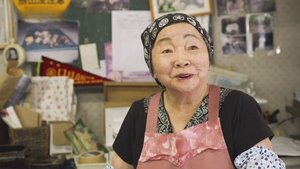
Minamiaizu Town, Fukushima Prefecture. Here, Akutsu Yasuko runs a fish shop renowned for its "marinated herring with sansho Japanese pepper" dish. Starting in late July, her rural town holds a festival with an 800-year history. Locals and those who have moved away reunite for this summer celebration. A festival staple is marinated herring. Join us as we visit Yasuko's kitchen, where she has lovingly and meticulously prepared this dish for eager festival-goers.
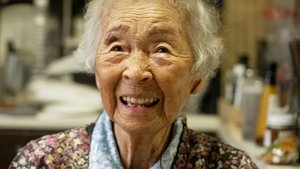
The people of Tokunoshima live long, and well. But one woman on the small Japanese island stands out. At the sprightly age of 93, Mizumoto Mieko's passion for cooking local specialties shines brighter than ever. Many of the dishes at her cozy restaurant are served on banana leaves, and they're filled with fresh ingredients that she insists on sourcing herself. Mieko is a force of nature, but she's happiest when relaxing at the dining table with her large family spanning a whole four generations.
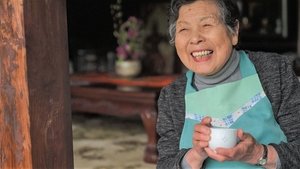
Much of Japan's renowned Uji tea is produced in Minamiyamashiro, the last remaining village in Kyoto Prefecture. Headed by women for the past three generations, the Nakanishi family has been harvesting tea in this remote mountain area for over 130 years. Today, even at the age of 90, Nakanishi Sachiko tends to the farm daily. Together with her daughter Chikayo, she finds time to make wonderful meals utilizing local produce.
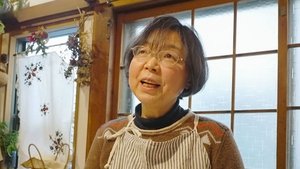
Suzuki Kinue knows a thing or two about making delicious bento boxed meals. She's been operating a tiny store in Tokyo's trendy Jiyugaoka neighborhood for more than a quarter of a century. It's only open twice a month these days, but that doesn't stop the locals from coming for her famous home-style cooking, perfected over generations and lovingly preserved in eight handwritten recipe books. Ask a customer to describe her steamed rice, and we bet you'll be joining the queue too.

Ito Chimomo leads a wonderfully rustic life in the picturesque town of Hayama, close to the sea and surrounded by nature. Her garden is filled with all sorts of herbs and fruit, which she harvests all year round. Good food is central to her world, and she's happiest when sharing home-cooked meals with her children and grandchildren. Time with family is made even more precious because she knows the true depths of loneliness, having been orphaned as a child and often left to fend for herself.

Anda Yuko, owner-chef of a Tokyo restaurant, has a singular philosophy. On first glance her food looks like unfussy, prosaic home cooking. But fans become hooked on the way she extracts the maximum flavors of her ingredients through minimal cooking and seasoning. Recently she started growing her own vegetables. What doesn't go into a recipe she will dry or pickle, leaving zero-waste. Her lifestyle choices have been influenced by Japan's 2011 earthquake and volunteer work in Peru. We peek into her kitchen to explore her imaginative cooking.
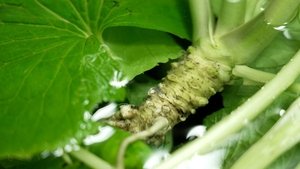
If you duck under tree branches, wade up a stream and climb over rocks, you will find a secret place of wasabi patches, tended by the Tsunoi brothers. Farmers have long cultivated wasabi over Okutama's stone terraces-stacked one rock at a time-in a place where spring water constantly flows. But super-aging has hit the farming community. The Tsunoi brothers have stepped in by not only growing wasabi, but also creating recipes using it to keep the tradition going.

Babies are about 6 months old when they gradually stop drinking breast milk or formula and start eating solids. It's a precious stage of our lives, but many mothers struggle to find the time to cook weaning food. It needs to be soft, and if it's not tasty, their little ones won't eat it. Tagami Maki is on hand to help. Her delicious recipes always bring big smiles to babies and mothers alike.

The clear waters of the Akigawa River course through a verdant gorge, just 90 minutes west of Tokyo. They are home to a treasured fish that has been enjoyed for centuries -- the Ayu or Sweetfish. We meet 2 men who cherish this fish, in season briefly from early summer to early autumn. One has devoted his life to protecting its pure waters. The other saves its viscera to prepare a fermented delicacy. Their kitchens are full of gratitude for this life born and protected in the Akigawa River.

Deep in the countryside is the peaceful area of Maru-bashira in Iga in southern-central Japan. This tiny village of only about 650 people has long been known for a type of pottery called Iga ware. Even today, several potteries continue this craft. Fukumori Michiho is one of them carrying on the tradition. For over 400 years, her family's pottery has been firing its kilns. Michiho pours her heart and soul into making earthenware pots called "donabe." Her hope is that modern generations will come to appreciate this time-honored cookware. Creating her very own "donabe" recipes, she wants to see these traditional pots once again become a familiar sight in kitchens across Japan.
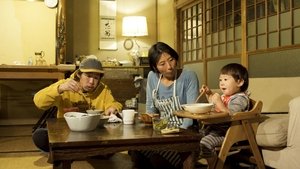
Hayama, a seaside resort to the west of Tokyo, is known for its high-quality vegetables and beef ... but not its seafood. But it wasn't always this way. Hatakeyama Akira, born and raised in the town, is determined to restore the place of her childhood memories. As the only fisherwoman in the port, she is working to revive the fishing industry, establishing a direct sales shop and her own kitchen. Her goal -- to bring Hayama's rich seafood culture back to local dining tables.
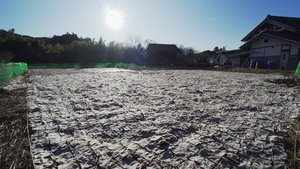
Shimi-konnyaku is a unique, naturally freeze-dried Japanese food, that would be able to be kept for 50 years. It was developed as a form of preserved food in early Japan. Toshi Nakajima, 89 years old, has been making this local specialty for 36 years. In the heyday, there were more than 50 producers in Hitachi-Ota, Ibaraki Prefecture, but it has been produced less and less because of the difficult work and harsh climate in winter. Toshi said, "Someone must keep local traditions." For him, Shimi-konnyaku is not only an ingredient, but also it's full of memories of his hometown and family. Visit the family life and the scenery created by Shimi-konnyaku in a quiet village in the mountains.
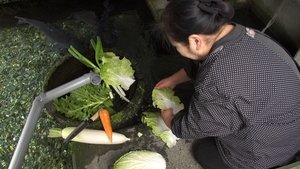
Lake Biwa is the largest body of fresh water in Japan. There's a town, Harie in Shiga Prefecture, on its northwestern shore, with a constant sound of water. Canals run throughout the town, as if to surround each house. Flowing there is all natural water that wells from underground. To make efficient use of this precious water, local people have created a type of kitchen, Kabata, that's unique to this area. Inside of this kitchen, the beautiful water flows from a well. This water has been supporting people's lives for 300 years. We'll visit some families in Harie, and see how these people have been creating the circle of life.
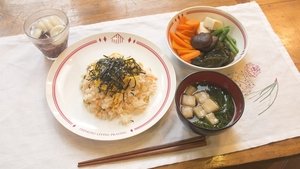
Jiyu Gakuen is a unique school in the Tokyo suburbs that emphasizes "learning from daily life." Every day, the middle or high school students have to prepare the school lunch themselves. This time, 20 students in the girls' division are tasked with making 280 meals within 2 hours. A leader is chosen, who must devise a cooking schedule as well as instruct the others. With the aim of serving delicious food, the students face hard work and challenges together, gaining valuable lessons in life.
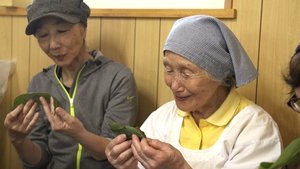
Something is always cooking in 92-year-old Misao Kuwata's kitchen. Every week she prepares 600 Sasa-mochi, a sweet steamed rice cake wrapped in bamboo leaves that is much-loved by locals. Drawing on the nature and traditions of Aomori Prefecture, where she lives, she adds a little of her own creativity to make delicious treats, and shares them with those around her. As we follow her hard work and careful methods, we discover Misao's secret to living a life full of happiness and inspiration.

The town of Monzenmachi in Ishikawa Prefecture is surrounded by both the sea and mountains. Here, Sayaka Mori (38) has decided to open a guesthouse limited to one group per night. Although she originally hated cooking, through learning from local teachers, she cooks dishes with ingredients she sources herself and shares the rich local food culture with her guests. This time, she prepares a special seaweed roll, made with seaweed that can only be harvested during a ten-day window.

Akio Okamura (75) is a man who lives by the sea in the quaint town of Matsuzaki. He's master builder of the Okamura Marine Craft, known throughout the country for the boats it builds and repairs. Outside of work, his passion is cooking for others - from spiny lobsters and crabs he catches himself, to sardines marinaded in his own secret sauce. We follow Akio as he generously shares food with those around him, both employees and neighbors, young and old.
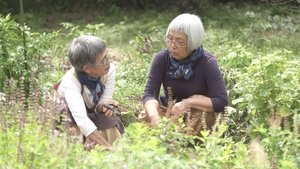
Sisters 69-year-old Akemi and 67-year-old Satsuki have embraced "shojin ryori," a kind of vegetarian cuisine practiced by Buddhist priests. What might seem a strict diet has evolved into a project of passion. The sisters have spent 2 decades cooking up a wide repertoire of delicious recipes, which they now share at cooking classes. This program follows preparations for one lesson, and how, through "shojin ryori," they've come to deepen their understanding of themselves and the world around them.

Recipes are often developed over several lifetimes of work, lovingly crafted and passed on from generation to generation. These dishes represent much more than home cooking. This program delves into traditional recipes to shine a light on unique food cultures across Japan, and discover the older generation's seasoned philosophies of life. Tami Hiyama, 92 years old, lives alone in Fukuoka City, where she has taught home cooking for more than 60 years. We learn her recipe for "chirashi-zushi," a special kind of sushi eaten at family celebrations. Tami prepares the finest ingredients but she says mindset is just as important -- she cooks the dish imagining those who will soon enjoy it. What does "chirashi-zushi" mean to 92-year-old Tami? We discover her recipes for life and the secrets of her good health.